The French Air & Space academy, a professional association/think tank, organized a conference about reusable launchers last week in Paris. There were two guest speakers:
– Xavier Pasco, head of the Foundation for Strategic Research, an official think tank that works with France’s Ministry of Defence. It is the French equivalent of the RAND Corporation in the USA, although with much less funding and a focus more on policy issues than on engineering problems. He gave an analysis of the factors that led to the creation of reusable launchers in the USA. In short, it was a perfect storm: the end of the Shuttle led to outsourcing the launch capability to new entrants, which enjoyed very comfortable contracts with NASA. That allowed them to take risks and innovate. Political issues such as Russian engines becoming politically sensitive and the increased vulnerability of US military satellites also gave a boost in the right direction, helping reduce ULA’s monopoly on defence launches. The full transcript might get posted in a future article.
– Jean-Marc Astorg, the head of CNES’ launch vehicles directorate. He spent his whole career at the directorate, working on Vega, Ariane 5 ECA, Soyuz in French Guyana, and was promoted director of launchers in 2015. He gave a much more technical talk on Europe’s response to US reusable launchers and its plans for the future. This article is a translated transcript of what he said, illustrated by the slides he showed during his presentation. The whole slide deck is just below:
Now let’s hear what the director has to say:
“
When I started to work at CNES in 1985, just after finishing engineering school, reuse had an extremely negative image. This was because of the US Space Shuttle, which completely failed to reach its initial objectives. It was to cost 30 million dollar per launch and launch once a week, and it ended up costing around 1 billion dollar per launch and launching 6 times a year. So we European built Ariane on the lost bet of the Shuttle. Today, Ariane 6 is the first European answer to the reborn American reusable rockets.

Before we go into details, a quick reminder on economic realities. Between 2017 and 2018, NASA’s budget increased, and that increase amounted to CNES’ whole annual budget. Regarding the global launch market, it represents around satellites per year, but only around 25 are open to global commercial competition. Most of the commercial launches are for geostationary communication satellites, but we do not know if the market will stay that way.
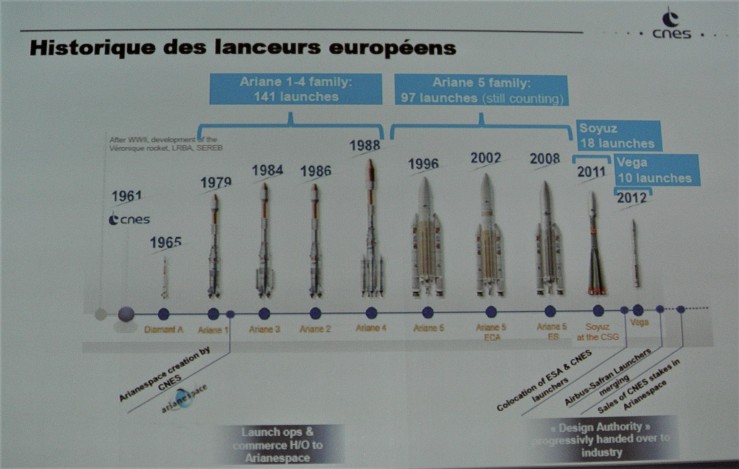
A bit of history on European launchers: Ariane 1 was an unexpected commercial success, thanks to the Shuttle’s failure. It was introduced at precisely the right time. With its evolution Ariane 4, we reached the maximum performance for the Ariane 1 concept, so we developed Ariane 5. For 20 years, it was the first commercial launcher in the world. The location of our launch site, Kourou, in French Guyana, was one of our advantages.
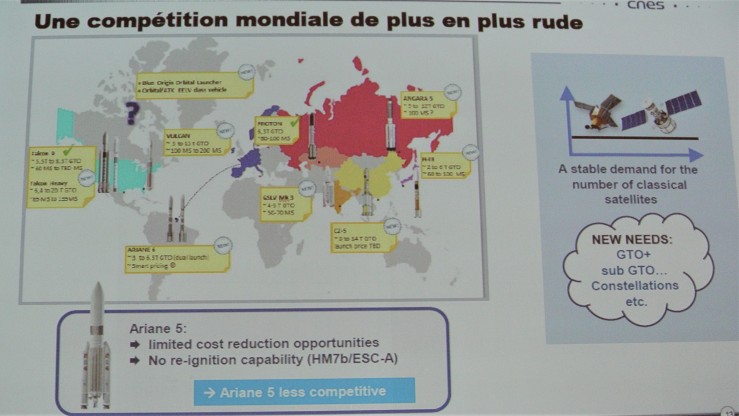
We reached an exemplary market share given the relatively small European funding. Nowadays, there is a political will from the USA to get back into the commercial market: they haven’t accepted being ejected by Ariane. There are also launchers in development all over the world, from public and private actors, because of an expected increase of the market. What matters for a launcher is to be as cheap as possible. Currently, the prices are around 10 000€ per kilogram in Geostationary Transfer Orbit (GTO). Note that most launchers in development are expendable launchers, so Ariane 6 is not an anomaly in that regard.
To give a quick overview of worldwide development efforts, the Chinese have a space program that makes us pale with envy, on all fronts, launchers and satellites. They have announced they are developing a reusable launcher too: Long March 8-R, to be ready for 2028.
In the USA, we should not oppose public and private space efforts: SpaceX is very much a creation of NASA thanks to technical and financial aid.

In Europe, the reason for being of the domestic launch capability is independent access to space. We realized that back in the day, when we wanted to launch our first communication satellite, Symphonie, on an American launcher. They accepted, but only on the condition it was not used commercially. This shows we need to be self-reliant. However, in Europe, the institutional market is small: at most 4 to 5 launches a year. So we need to get a share of the commercial market to make the industrial ecosystem viable.

We have anticipated the renewed US competition. Ariane 6 was initially proposed in 2009, when we realized that SpaceX’s Falcon 9 was a good launcher with high performance at low cost. So the main objective of Ariane 6 was to reduce costs. However, the decision to fund the program was only taken in 2014, which is very late. The slow speed of European decision-making is problematic.
Ariane 6 is an expendable rocket which looks a lot like Ariane 5, but we reduce its cost by 50% thanks to three things: the increased launch cadence, as it will replace the Soyuz launched from French Guyana, innovation (for instance instead of two 3-block metallic solid boosters we will use 4 monoblock carbon solid boosters) and a redesigned manufacturing process, with the introduction of lean management for instance. The objective is a cost of 10 000 € per kilogram in GTO for 2020. There is little technological ambition but a high organizational ambition.

Reuse is an old and obvious idea: it takes 3 years to manufacture a launcher (due to the lead time for the engines), it costs more than 100 million € and then we launch it and it ends crashing into the sea less than 30 minutes later. However there are different ways to implement reuse: Falcon 9 is fundamentally different from the Space Shuttle in that aspect. Only the first stage, the easiest to reuse, flies again. It separates at only around 2 kilometers per second, and represents 50% of the cost of the launcher. That’s a big difference compared to the Shuttle. Falcon 9 has reasonable technical objectives that it could reach step by step. The Shuttle had to much ambition for 1970.
There are several reuse strategies. Since the goal is to minimize the impacts on the stage, parachuting in the ocean is not an option: salt water makes the refurbishment to complicated. For Falcon 9 for instance, they use a toss-back trajectory. An engine is relit while going against the aerodynamic flow, which is actually quite complicated to achieve. We worked on that with ONERA, the French national aerospace lab, and realized it’s pretty complicated.
A key aspect of toss-back is that it enables to experiment on operational missions: after the second stage separates, the first stage can try to relight, change its course and land without impact on the commercial mission, and without much impact on the design on the first stage. For solution that use winged return on the contrary, the wings have to be added and carried by the stage during the ascent on the first stage, which might interfere with the mission. So toss-back is a method that works, that enables to experiment on expendable launches, that adds the minimum of components on the rockets. So it is the less costly and most interesting option.

Now reuse has pros and cons. The cons are the performance hit, up to -50% for a return to the launch site, the safety impact of having a stage return to its pad in Guyana -flying close to the city of Kourou- and an availability issue for ocean landings. In order to land on a barge, the weather conditions have to be good 400km away in the ocean, and can scrub a launch if they aren’t.
The pros are the possibility to have a higher launch cadence and to be more responsive when a launch is purchased, as we do not have to wait to manufacture the first stage. Also, reuse saves money if the refurbishment costs are low. These are actually critical to the whole equation. For instance, before Falcon 9 Block V, the Merlin engine developed crack in the turbopump, which means it had to be replaced and limited the launches without extensive refurbishment to 2 only.
An issue of reuse is that if you do not need to produce first stages any more, then you close your factories. However, if at some point you need to built a stage, you have to reopen them, which costs a tremendous amount of money. So it is important to use the same engine for the first and second stage, to keep it in production.

What can Europe’s strategy for reuse be? First, we would not do only reusable launches. Geostationary and escape missions would be expendable. For low Earth orbit mission, we would use a return to launch site trajectory. That would enable us to do a few reuses per stage, and keep the manufacturing rate not too low while saving 30% on costs. So partial, reasonable reuse is accessible. However it needs a lot of developments, because we need to master a lot of complex physical phenomena. Still it is interesting, even with today’s market. If the market soars, it even becomes necessary.
Among the developments to be done is engine thrust modulation. It can create combustion instability problems and we have not studied it in depth before because it was not necessary. So on the short term, Ariane 6 is the only solution to lower costs. On the long term, reuse and other technologies, such as 3D printing, will reduce them further. 3D printing could revolutionize the manufacturing of combustion chambers, which is currently very time-consuming.
We have put our priority on propulsion, and on using a step by step, experimental approach. We have to test things. Regarding engines, we currently use Vulcain, which is an hydrogen engine based on an old original design. We are developing Prometheus, a methane-oxygen engine, with the objective to reduce costs. That does not mean we will give up the hydrogen industrial base, we will have to see. Methane has the advantage to be halfway between hydrogen and kerosene. It’s much easier to handle than hydrogen, while having better performance than kerosene, so the engine can be cheaper. It is also denser than hydrogen, which makes tanks smaller and stages cheaper too. We are building two prototypes for a test fire in 2021.
Prometheus can be used in a new architecture which we call Ariane Next. It will have 7 such engines on the first stage and 1 on the second stage, and can be used in expendable or reusable mode, allowing to experiment reuse easily. The objective is to learn by testing, which is not a European speciality.
Before Ariane next, we have a step by step approach, first with Callisto. For this demonstrator of first stage reuse, we had no reusable engine in Europe so we partnered with the Japanese. The we will move on to the larger-scale Themis demonstrator with Prometheus engines. The concept is still in definition phase.

Ultimately, we will have to do a choice between an evolution of Ariane 6 and a brand new launcher, to be ready in 2028-2030.
“
Q & A
Q: Where would you refurbish the stage?
A: In Kourou, because otherwise shipping to Europe makes it too expensive. And refurbishment has to be minimal anyway for the concept to work.
Q: What do you think of reusability for small launchers and suborbital rockets
A: We focus on large launchers because that’s where there core market is and we do not have the resources to do everything.
Q: Callisto looks very much like Grasshopper, the SpaceX Falcon 9 first stage reuse prototype.
A: Callisto is Grasshopper. The Chinese are also building a similar prototype, I have no problem saying we didn’t invent anything.
Q: Prometheus looks cheap to produce, why not put more engines per launcher to further increase the manufacturing rate?
A: We start our design by a market analysis. While I am not able to predict what the market will be in 2030, 7 Prometheus engines is optimal for the current market.
Q: Do you plan to go to Mars?
A: We are already going to Mars, the instrument carried by NASA’s Insights Mars probe is the French SEIS seismometer.
Q: We seem to lag 5 to 8 years behind the US, are we going to catch up?
A: While Musk has led us into a new chapter of launch vehicle history, his model of full reusability is not the only one. I expect the market to be half reusable and half expendable in the future. For instance, the US Air Force is currently funding the development of expendable rockets.
Q: What about 3D printing?
A: I visited Relativity Space in April and thanks to 3D printing, they developed a 10-ton class methane engine in 2 years and tested it at NASA Stennis. They want to print a full launcher. While I do not believe they will achieve that, I think it can be a breakthrough as big as reuse. On Ariane 6 for instance the Auxiliary Power Unit of the second stage is 3D-printed, it would be too complex to manufacture otherwise. So I expect very significant cost reduction thanks to 3D printing
Q: What are the weather limits for barge landing?
A: Heavy seas make the barge move too much and can make the stage tip over. That’s why SpaceX developed a system to grab the rocket. Blue Origin has a different concept, they will use a boat with hydrodynamic control surfaces for stability. The boat has to have some speed and the rocket has to match it.
Q: What do you think will be the impact of megaconstellations like Oneweb?
A: I have no crystal ball. But I am seeing that because all the satellite operator have adopted a kind of wait & see approach to the introduction of megaconstellations, they have put some satellite orders on hold and the commercial market is decreasing. It’s 17 satellites per year currently, while it used to be 30 per year some time ago. The constellations will have to face the competition of GEO satellites and of ground networks, so it is possible they will fail like in the 1990s. Then the market would certainly not be multiplied by 10.
Q: What do you think of the market elasticity?
A: Up to now the elasticity has been low. GTO launch costs have decreased from 20 000€/kg to 10 000€/kg and it did not have a lot of impact on demand. If we reach 5 000€/kg, it’s not certain it will have a big impact. The problem is even at that price the cost of access to space remains high. So we are not basing our models on market elasticity.
Q: How do you ensure first stage return is safe for the population?
A: It’s hard, we will use Callisto to show that we master safe trajectories.
Q: What about second stage reuse?
A: We consider the impacts on performance to be prohibitive so we are not working a lot on it.


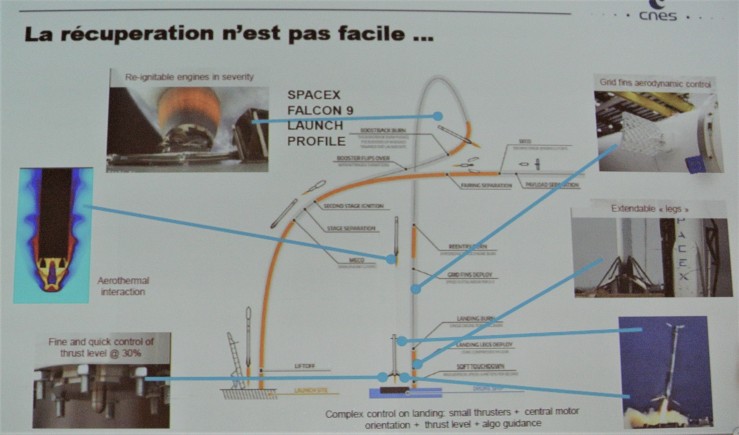

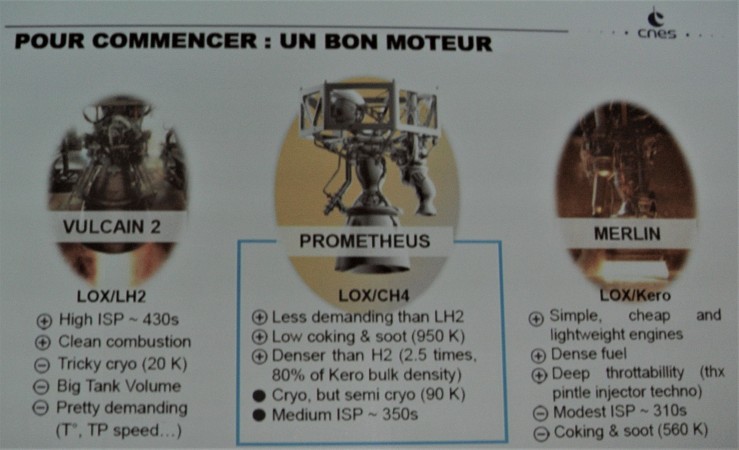
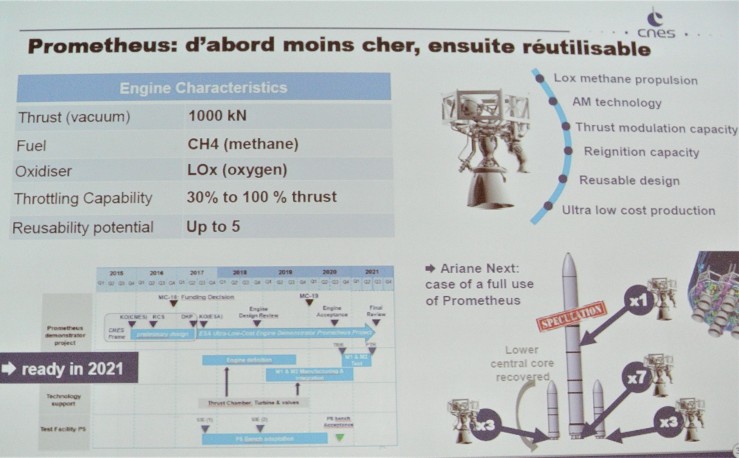
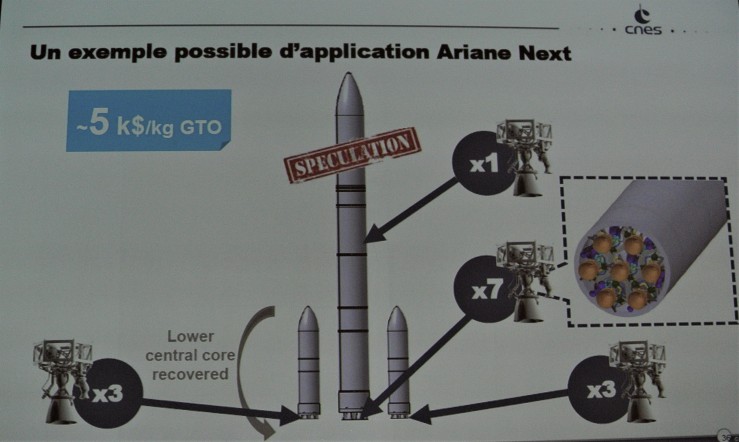



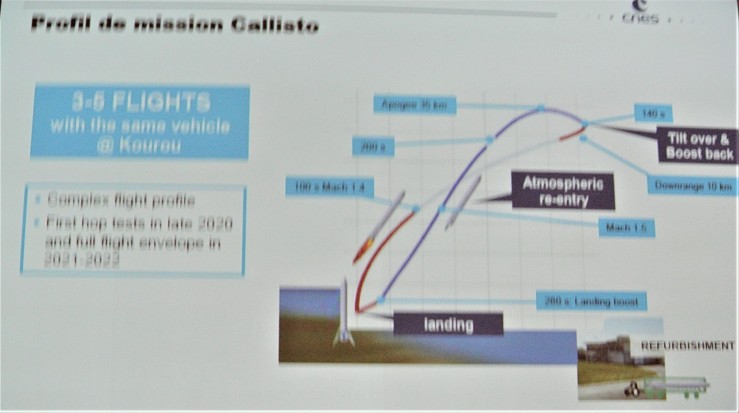
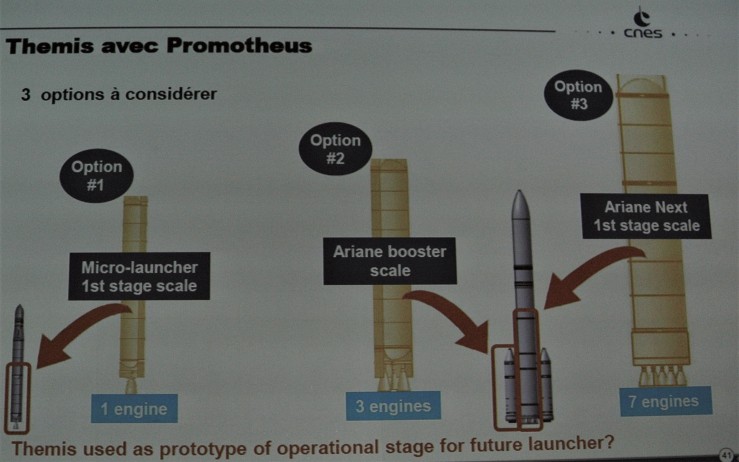
[…] https://satelliteobservation.net/2018/06/02/cnes-director-of-launchers-talks-reusable-rockets/ […]
LikeLike
[…] Don’t listen to the previous guy… […]
LikeLike
[…] View Reddit by Saint_eX – View Source […]
LikeLike
[…] Оригинальная статья […]
LikeLike
One of the best articles I’ve read on this, done in a European style with appropriate level/scope of detail.
However, the changing business environment for the global space launch environment is underappreciated and unstable for all the traditional launch providers, and the absence of this understanding slows rapid adaptation like might be needed to retain market share. Worse yet, in attempting to prop up Ariane 6 with more indigenous payloads “locked in”, the losses of the ill-timed noncompetitive launcher might damage the European spacecraft industry at an equally crucial time where rapid growth in quick turn, low-cost spacecraft on rapid reusable launch might happen.
LikeLiked by 2 people
[…] is Grasshopper,” Astorg said at the time. “The Chinese are also building a similar prototype, I have no problem saying we […]
LikeLike
[…] is Grasshopper,” Astorg said at the time. “The Chinese are also building a similar prototype, I have no problem saying we […]
LikeLike
[…] is Grasshopper,” Astorg said on the time. “The Chinese language also are construction a an identical prototype, I […]
LikeLike
[…] is Grasshopper,” Astorg said on the time. “The Chinese language also are development a identical prototype, I […]
LikeLike
[…] is Grasshopper,” Astorg said at the time. “The Chinese are also building a similar prototype, I have no problem saying we […]
LikeLike
[…] is Grasshopper,” Astorg said at the time. “The Chinese are also building a similar prototype, I have no problem saying we […]
LikeLike
[…] is Grasshopper,” Astorg said at the time. “The Chinese are also building a similar prototype, I have no problem saying we […]
LikeLike
[…] is Grasshopper,” Astorg said on the time. “The Chinese language also are development a identical prototype, I don’t […]
LikeLike
[…] is Grasshopper,” Astorg said on the time. “The Chinese language also are construction a identical prototype, I […]
LikeLike
[…] is Grasshopper,” Astorg said at the time. “The Chinese are also building a similar prototype, I have no problem saying we […]
LikeLike
[…] of their Callisto first stage to the Falcon 9’s first-stage reuse prototype Grasshopper in an interview last year: “Callisto is Grasshopper. The Chinese are also building a similar prototype, I have no problem […]
LikeLike
[…] of their Callisto first stage to the Falcon 9’s first-stage reuse prototype Grasshopper in an interview last year: “Callisto is Grasshopper. The Chinese are also building a similar prototype, I have no problem […]
LikeLike
[…] of their Callisto first stage to the Falcon 9’s first-stage reuse prototype Grasshopper in an interview last year: “Callisto is Grasshopper. The Chinese are also building a similar prototype, I have no problem […]
LikeLike
[…] of their Callisto first stage to the Falcon 9’s first-stage reuse prototype Grasshopper in an interview last year: “Callisto is Grasshopper. The Chinese are also building a similar prototype, I have no problem […]
LikeLike
[…] https://satelliteobservation.net/2018/06/02/cnes-director-of-launchers-talks-reusable-rockets/ […]
LikeLike
[…] CNES’ director of launchers talks reusable rockets […]
LikeLike
Sounds promising. Originally, the profit model for the new generation of ESA rockets was built on the premise that printable engines (i.e. Prometheus) would allow for expendability and prevent the costs associated with re-appropriating captured/and-or vertically landed rockets.
Also. Wasn’t Callisto originally supposed to be a horizontal lander……………….. or was that a different project named after an equally esoteric and enchanting Roman-Greek Deity ?
LikeLike
[…] has given an update on the French Space Agency’s roadmap on future launchers. Compared to previous iterations of this roadmap, it now has more details on how to reach its ambitious goal: halving launch costs […]
LikeLike
Hey There. I found your blog. This is a really well written article.
LikeLike
Thank you for the auspicious writeup. It if truth be told used to be a enjoyment account it. Glance advanced to more introduced agreeable from you! ij.start.canon Setup
LikeLike